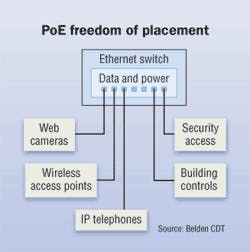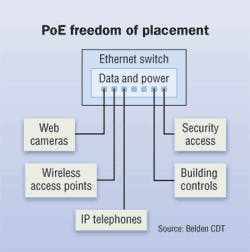An enhanced IEEE 802.3af standard looks to provide the maximum practical power over an existing LAN infrastructure.
Power over Ethernet (PoE) refers to the ability to power network devices over the existing data wiring, eliminating the need for an external power supply for each device. With PoE, devices such as IP telephones, wireless access points (APs), security cameras, and other enterprise terminals can safely receive power over legacy LAN cabling without modifying the existing infrastructure.
Problem solving for IP phones
The initial push for PoE occurred with the advent of Voice over Internet Protocol (VoIP). Initially, Cisco and other providers shipped IP telephones with proprietary interfaces; however, after the Institute of Electrical and Electronics Engineers (IEEE; www.ieee.org) ratified the 802.3af standard in June 2003, the major IP phone manufacturers adhered to this standard.
PoE solved a significant problem for IP phones, making them virtually as useful and convenient as conventional telephones. Because PoE technology enables the power for IP telephony to be carried over existing twisted-pair Ethernet data cables (Category 3, 5, 5e, and 6), it provides the freedom to place the phones so they do not have to be plugged into a nearby alternating current outlet.
Since IP phones have been widely distributed, the IEEE is now expanding the 802.3af standard further to accommodate a myriad of other devices within a network capable of running on power through data cables. PoE would allow freedom of placement, eliminating the need for AC outlets for powered devices (PDs), such as IP security cameras in hallways and parking lots, magnetic card readers, building access ports on exterior walls, wireless APs in drop ceilings, emergency alarm systems, and radio-frequency identification throughout a facility. PoE would also allow for battery backup of these devices, many of which are critical for maintaining building security and access control. With PoE, they could all be on an uninterruptible power supply and, as such, would not go down when the building power goes out.
IEEE 802.3af standard
Under the existing IEEE 802.3af standard, PoE injects balanced currents into two of the four data cable pairs. The PoE-powered switch injects power using the same pairs that carry data (pins 1-2 and 3-6). PoE midspan devices inject power onto the normally unused pairs (pins 4-5 and 7-8).
The highest power classes available today under the current standard (Power Class 0 and Power Class 3) provide 15.4 watts (W) minimum-derived from the minimum voltage of 44 volts (V) times the minimum current of 350 milliamps-at the power sourcing equipment (PSE), which is either a PoE-powered switch or a PoE midspan.
Because the cable segments can be as much as 100 meters long, this reduces the power (through losses due to cable resistance) to 12.95 W minimum at the PD. Until recently, this level of power has not presented a problem. Most VoIP phones, which are considered to be the first “killer app” for PoE, require only 8 W or less, particularly when idle; however, newer devices demand more power, and that challenge is at the core of today’s debate over PoE technology.
So, what’s next?
The IEEE recently formed the PoE Plus Study Group, charged with a mission to determine the next steps in developing an enhanced 802.3 standard. Thus far, the group has defined 14 specific objectives, including:
• Enhance the 802.3af standard within its existing framework, providing both forward and backward compatibility.
• Introduce no new safety issues for legacy systems conforming to ISO/IEC 60950. This means that any new PoE Plus PSE introduced will not damage, and will interact properly with, existing PoE devices.
• PoE Plus will have operating modes compatible with existing IEEE 802.3af equipment and with newer enhanced modes. When the original standard was defined, it included a Power Class 4, which was reserved specifically for a new, enhanced standard to come.
• PoE Plus will provide “the maximum practical power” to the PD over the existing LAN cable infrastructure.
What is maximum practical power?
To date, the PoE Plus Study Group has not reached agreement on what “maximum practical power” means. There is clearly a surface temperature limit on Category 5, 5e, and 6 cables, but there is some debate about what the temperature limit should be to support PoE Plus. Should it be 60° or 70° C, or possibly even higher? That remains undecided for now.
Another topic of debate is determining the real maximum ambient temperature in the PoE Plus operating environment. Because power is dissipated at the cable, the cable would be rated to zero current if the ambient temperature measured the same as the cable’s highest temperature. So, some headroom needs to be built into the new standard. The debate is over what that difference in temperature should be.
Additional questions in the same vein include: What is the “worst-case” temperature rise for the middle cable in a cabling bundle or cable tray? What standard applies for the current capability of this type of cable and network infrastructure?
These are difficult questions. While the system connectors-8-pin modular, RJ-45s-are characterized in terms of their current-carrying capabilities and temperature, it is a new concept to try to determine the maximum current-carrying capabilities of the cable itself.
With the PoE Plus Study Group not yet having chosen a power level, the temperature rise-particularly for a cable within a large bundle in a cable tray, in a ceiling, or through a wall-doesn’t yet seem to have an accepted industry thermal model. As a result, it is difficult to determine just where the hottest spot on a cable will be.
Forward and backward compatibility
Because the PoE Plus Study Group is looking ahead to Gigabit Ethernet and beyond, it wants the new standard to provide forward compatibility. But the group also wants to ensure backward compatibility so that users are able to power existing PDs from the new equipment. This backward compatibility necessitates setting the upper voltage limit at 56-V or 57-V to avoid damaging or destroying older PDs.
Because the equipment designed to support 10/100/1000 Mbits/sec requires that all four pairs be routed through for data, there is a question of whether all four pairs should carry current. Most in the study group support the idea. Yet if that were the case, then all of the wires in a given Ethernet link would be generating heat. So, returning once more to the issue of temperature limits, the question is how such limits can be accurately determined.
Gigabit Ethernet also has more stringent balance requirements for transmission/reception of the Ethernet signal, meaning there is some question about whether the current balance in each individual pair also has to be more stringent than it was under the prior standard.
Gig to 10-Gig
One other important goal the study group is considering is that the development of the IEEE 802.3af PoE Plus standard must not preclude or be inconsistent with 10-Gbit Ethernet compatibility.
This issue led into the maximum-practical-power debate. The study group’s goal was to set the power level somewhere in excess of 30 W per port, and members even discussed ramping up to a power level of 100 W per port. The latter proved unacceptable to all, and the present consensus seems to be the 30 to 50-W per-port range, which would enable a whole new class of devices to be fielded on PoE Plus. For example, even an average laptop computer could be powered and operated indefinitely within this power range.
The 8-pin modular (RJ-45) connectors on both the PSE and PD have clearly defined current-temperature limits. So, the real crux of the debate over maximum practical power is: ‘What current-temperature are the cables able to take, and what kind of standards can be referred to for measuring and modeling these parameters?’
It is clear that Power over Ethernet holds great promise for transforming the communications networks of the future. Our overriding goal in developing the enhanced IEEE 802.3af PoE Plus standard is to ensure a safe and reliable network cabling infrastructure in those buildings in which PoE Plus will be implemented.
Stay tuned, because when it comes to PoE Plus, there will be much more to come.MICHAEL POSEY is a consulting engineer for Belden CDT (www.beldencdt.com) and a 24-year veteran in the design of advanced communications and networking products.



